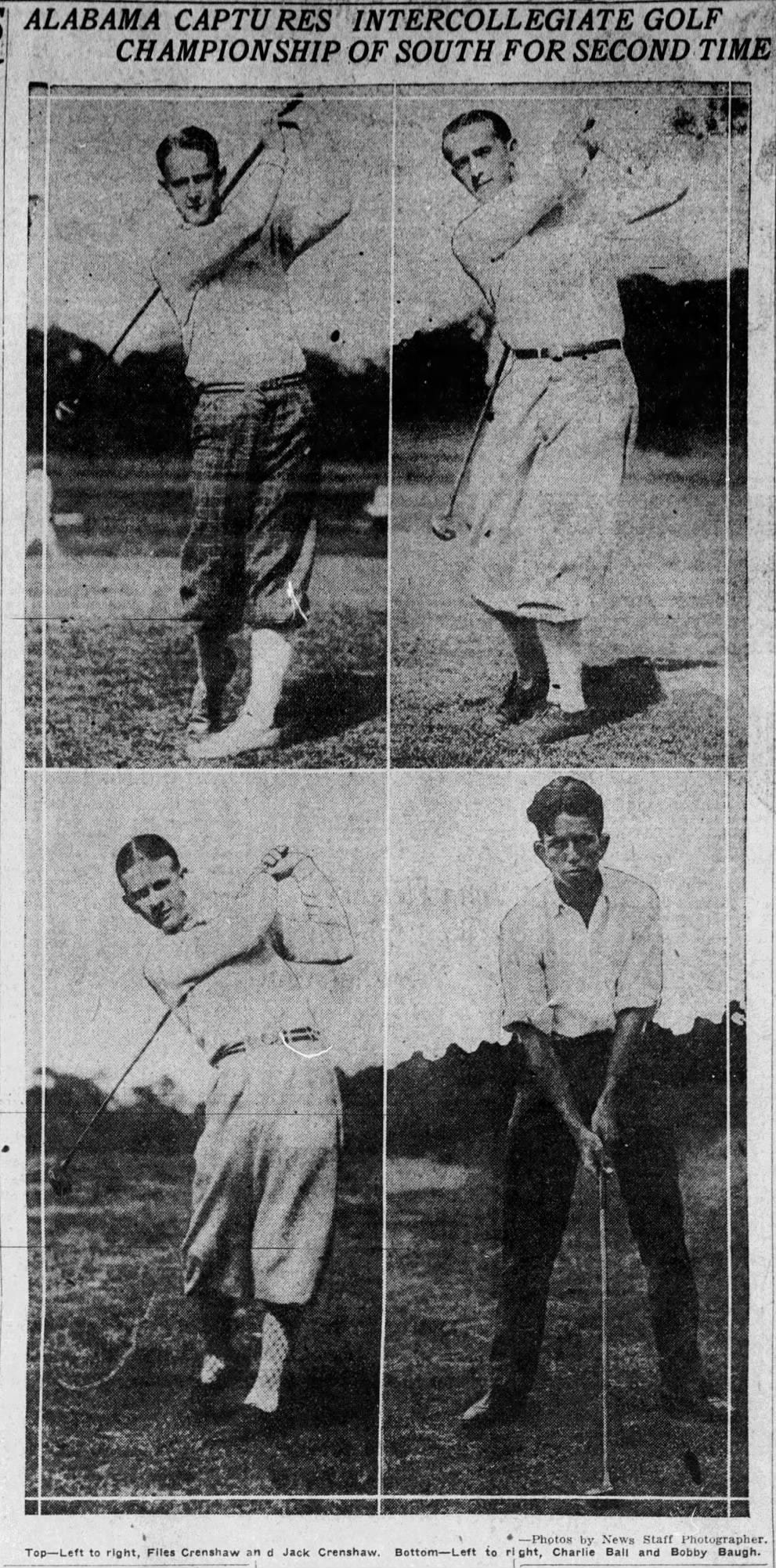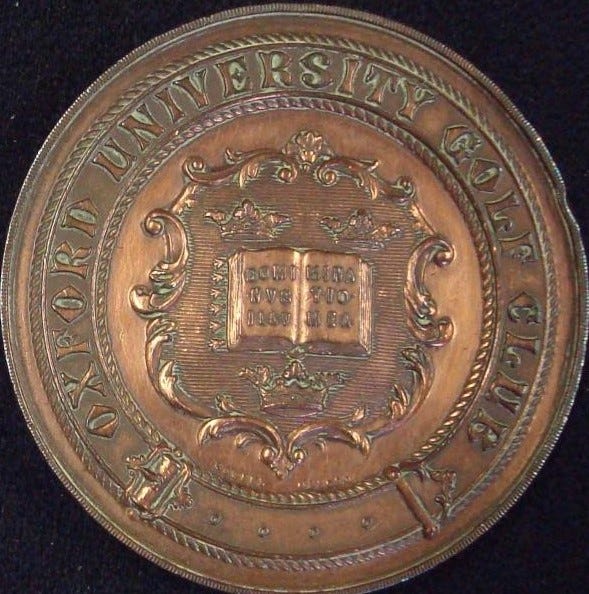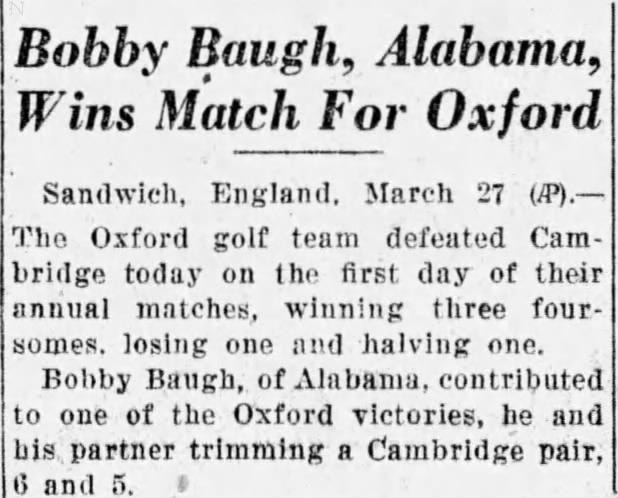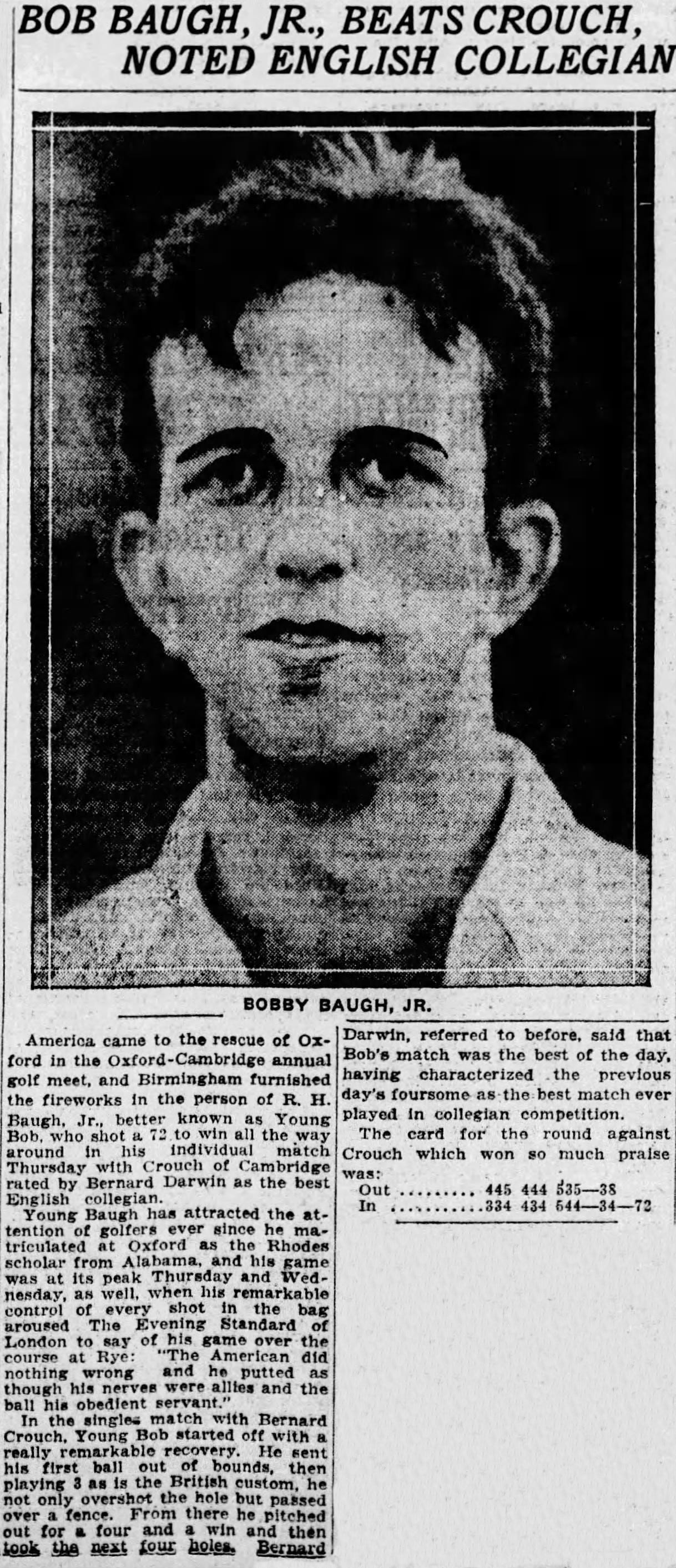BOBBY BAUGH: OXFORD’S ALABAMA CAPTAIN
Earning the captaincy of a college golf team is a special honor that relatively few have enjoyed. Even fewer can say they were able to captain two different college teams. In all of collegiate golf history we would venture to guess that the number of players who can say they captained two teams on two continents may be in the single digits. Who would have thought that a young man from Birmingham, Alabama would become so important in British collegiate golf that he would find himself photographed in a place of honor alongside two future kings and Bobby Jones, a man who was practically British golf royalty.
*Note: Underlined text is a link to a reference material and/or more details

ALABAMA

Background
Robert Henry “Bobby” Baugh Jr was born in Birmingham, Alabama in 1906. His father, R.H. Baugh Sr, was a prominent man in the Birmingham area and a fairly decent golfer himself, owning the honor of having medaled in the very first Southern Amateur golf tournament held in 1902. It was about that time that Baugh Sr became President of the Country Club of Birmingham, the club (but not the same location) where in 1899 he brought golf to the city with an extremely crude “course” that consisted of 9 tin cans buried in a nearby field. The Club eventually updated both the course and facilities, and it was here that young Bobby learned the game.
*Interesting side note: there are at least two NCAA individual champions with ties to the Country Club of Birmingham. Both the 1940 champ, F Dixon Brooke (Virginia), and the 2022 champ, Gordon Sargent (Vanderbilt), grew up playing at the course.
1924
Bobby Baugh entered the University of Alabama the year after golf gained legitimacy at the school as a “minor” sport. Although freshmen at schools in the Southern (Intercollegiate) Conference (SIC) weren’t allowed to compete in “major” sports such as football and baseball, they were allowed to compete in minor sports which is how Bobby was able to join Files Crenshaw and his brother Jack on one of the most formattable collegiate golf teams in the South.
That first Alabama team in 1923 was organized in time to participate in the first ever Southern Intercollegiate Golf Championship, spearheaded by Tennessee’s Moss Yater who also became the first President of the Southern Intercollegiate Golf Association (SIGA). Because of golf’s status as a minor sport, this tournament wasn’t considered an official conference championship, and would continue to be organized by the student-run SIGA - not unlike the IGA running the national championship - throughout the 1920s.
Georgia took home that first team trophy in 1923 during the stroke play portion while Alabama’s Jack Crenshaw won the individual title in the finals match against (future national champion) Fred Lamprecht [Tulane]. Alabama dominated the 1924 edition, winning the team title by 22 strokes as Bobby Baugh took home medalist honors. Alabama took 3 of the 4 semifinalist spots with Files Crenshaw defeating Bobby to make the Finals against Lamprecht who bested Glenn Crisman. Lamprecht once again finished runner-up to a Crenshaw brother as Files took the individual championship the next day. The victory, considered a conference championship in all but name, earned the Crimson Tide golfers the first “letters” for that sport in the University’s history.
1925
Not weighed down by the hefty expectations, Bobby’s sophomore campaign was even more successful than the year prior. Not only did Baugh repeat as medalist in the SIC tournament, the Alabama team he captained repeated as team champs and Bobby made it all the way the Finals where he lost to Lamprecht on the 36th hole. An interesting twist with this year’s championship was that the IGA had agreed to let the individual winner (Lamprecht) and runner-up (Baugh) compete as individuals in the national championship despite the fact that their teams were not members of that organization. Both players represented the South well at the tournament held at Montclair GC in New Jersey at the end of June, both advancing to the individual match play portion. Baugh fell in the first round to Princeton’s George Hackl Jr, but Lamprecht shocked everyone by becoming the first non-East Coast player - Princeton, Harvard, Yale, Columbia, Dartmouth - to take home the individual title.
1926
In what had become a predictable result, Alabama once again took home the team SIC tournament title thanks in large part to junior Bobby Baugh medaling for the third straight year. This time Baugh was able to capture the individual title as well with a 2up victory over Joel Turnbull [Sewanee]. Fittingly, Baugh was also named the President of the SIGA for the coming year. It’s unclear if the IGA/SIGA agreement from 1925 was just a one-year deal or if both Alabama and Sewanee declined to send their players to the national championship, but in any case Baugh did not make the trip to Merion at the end of June. Lamprecht, who may have been invited due to his status as reigning champion, did make the trip and remarkably was able to defend his title.
1927
The impossible run of SIC team titles and medalist honors finally came to end in Baugh’s senior year. Georgia Tech finally unseated Alabama, led by Walker Cup superstar Watts Gunn who took home medalist honors. Gunn also took the individual title with a victory over Alabama’s Johnnie Thames while Baugh fell in the early stages of match play. Although neither Baugh nor Thames made it to the IGA championship, the SIC was well represented as Watts Gunn made it three years in a row that the national individual title had been plucked from the East Coast and brought down South.
Collegiate Legacy
Although he wasn’t in the national spotlight for winning the IGA individual championship like Lamprecht and Gunn, Bobby Baugh was well regarded throughout collegiate golf for both his and the Alabama team success. During their three year SIC run, Alabama was the unquestioned rulers of Southern intercollegiate golf and Baugh garnered high praise as captain for two of those years. Little did he (and everyone else) know, this was actually only the beginning of his collegiate golf legacy.
OXFORD
Background
Bobby Baugh left the University of Alabama as a Rhodes Scholar, choosing to head to England in August of 1927 ahead of the start of fall classes at Oxford. He told the Birmingham News it was to “...get my bearings and looking things over and I found everything agreeable and interesting.” It didn’t take long before it became apparent that the feeling was mutual.
“The British do not differentiate between their own and Americans at all. I think the British like American individually; if a fellow is half way decent, he is received by them very cordially, and in a very friendly manner. The easiest approach to a British-er is to have him admire one for athletic skill, or to be of the same reserved nature that he is; not to thrust oneself upon him; but be very conservative; not slap a fellow on the back and do other familiar things. If this is followed, you have a friend for life.”
-Bobby Baugh (Jr), 1927
1927-1928: YEAR ONE
Baugh’s golfing experience for Oxford started soon after arriving. The typical experience for a man wishing to earn his “Blue” (letter) as a member of the Oxford University Golf Club (OUGC) was to play in the series of frequently changing weekend matches through multiple school terms until, when deemed worthy, finally being tapped to play in the annual match against Cambridge. As the first of many exceptions, Baugh was asked to join the Oxford team in his first term. This by itself was an exceptional feat, but adding onto that was the fact he was one of the very few Americans to be on the team at all made it an extremely rare accomplishment. He soon made a considerable impression on the British golf media with a highly publicized victory in a friendly match against 1923 Open Champion Arthur Havers. If that wasn’t enough, he further proved his worth by winning the Oxford University championship.
A couple months later, Baugh’s respectability rose another notch in the eyes of his British peers when he earned a point for Oxford in the annual match against Cambridge. This competition, known as the Varsity Match or University Match, predates the Intercollegiate Golf Championship in the United States (1897) by nearly 20 years (1878). With so few collegiate golfing opportunities compared to its American counterpart, this match was essentially the collegiate golf championship and given that amount of reverence.
Both Oxford (OUGC) and Cambridge (CUGC) had enjoyed stretches of success in the Match, however Cambridge extended their current streak to three with a come-from-behind victory in the 1928 edition. Cambridge took 7 of the 10 singles matches on the second day - one of those being Crouch’s 6&5 drumming of Baugh - to win the overall match by 2 points.
1928-1929: YEAR TWO
Much the same way he had stepped up to meet lofty expectations in his sophomore campaign at Alabama, Baugh - now commonly referred to respectably as “R.H. Baugh (Jr)” - continued to impress in his second year as an OUGC member. His rematch against Crouch, now considered one of the best British collegiate players, resulted in the complete opposite score as “Young Bob” took the 6&5 victory. Unfortunately for his brothers in dark blue, Cambridge had taken most of the other matches and had once again extended their overall win streak to four.
1929-1930: YEAR THREE, FINAL YEAR
A few months after the 1929 match, R.H. “Bob” Baugh Jr was named OUGC Captain for the upcoming year. Of all of his collegiate accomplishments, including captaining the Alabama contingent to multiple SIC team titles, this was by far the most rare and perhaps most prestigious. Never before had an American achieved this honor, and with it came the acceptance into the exclusive Oxford and Cambridge Golfing Society, said the oldest (1898) in the world.
“Baugh’s one ambition, at the moment, is to retrieve the fortunes of Oxford in the ‘Varsity match. In this event most credit, if not all, will be due to Baugh, whose influence as the leader of the side is most marked. This year a precedent has been created in the annals of golf at the Universities, Baugh being the first American to captain either team. The only complaint I have against Baugh is on the score of nationality, because I cannot help feeling that if he had been born in this country he would have been a worthy representative of British golf.”
-The Illustrated Sporting and Dramatic News (Dec 1929)
By the time the University Match rolled around the following March at Hoylake, the hype had gotten about as high as had been seen in recent memory. In his day one 36-hole foursome match, Baugh and teammate Sweeney blistered their opponent group, which included the Cambridge captain, by the score of 10&8. At the end of the day, Oxford held the 4-1 advantage. In the second day singles matches, Baugh once again gained Oxford a point by beating the Cambridge captain 4&3. This time, there was no comeback for Cambridge as Oxford took 8 of the 10 matches and snapped Cambridge’s 4 year win streak.
“Few Americans have ever attended Oxford University who have been as popular as Bobby Baugh, Jr, of Birmingham, Ala., U.S.S, and it is easy to see why, because he is very democratic, very friendly, and withal very reserved; a lovable personality in addition to being a corking good golfer, than which, to Britishers, there is no higher recommendation.”
-Dolly Dalrymple, Birmingham News, 1930
As he completed his time at Oxford, Baugh found that several prominent doors had been opened for him. In May he was invited to a private affair at the prestigious estate of Sir Philip Sassoon - located a few miles north of London - which included Baugh’s Oxford team, the recently victorious American Walker Cup team lead by Bobby Jones, and two future kings of the British monarchy, Edward VIII (then Prince of Wales) and George VI (then Duke of York). A photo of the event which features Baugh in line with British royalty and golfing royalty was later sent to him and said to be one of his most prized possessions.
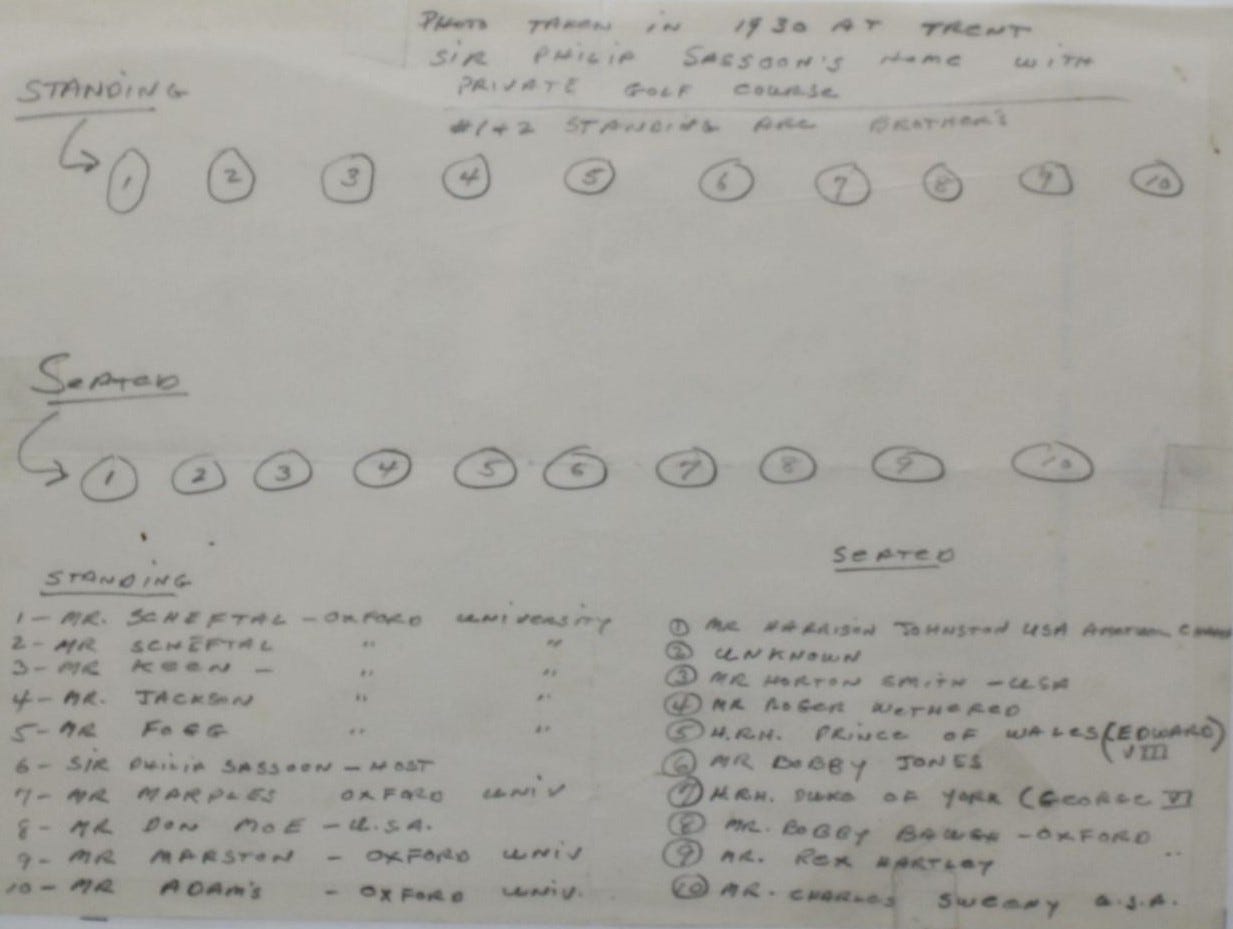
AFTERWARDS
After an incredible collegiate career overseas, Bobby Baugh returned home to Birmingham, Alabama in September 1930. Despite some predictions that Baugh was on the Bobby Jones path of potential golf superstardom, the results never really came. He had represented his country well at the British Amateur and won over the famously cold locals (at least to non-Bobbys apparently), but the major amateur victories eluded him. So too did the inclusion on any of the Walker Cup teams, although it was suggested by a couple of sources - perhaps with tongue-in-cheek - that was due to his closeness with the British players as much as his resume.
With golf remaining a non-professional pursuit, Baugh told the Birmingham News after concluding his studies in physics while at Oxford that the theoretical sciences were not for him (professionally) either, and that he actually had other plans:
“I am going into business. When I went to Oxford I wasn’t sure whether I’d continue my scientific work. I do not consider there is much future in it.
Although his career path isn’t precisely known, it appears that Baugh joined the Monsanto Industrial Chemicals Company sometime in the 1930s - possibly through the 1935 acquisition of Swann Chemical Company based in Anniston, Alabama - which brought him up to Cuyahoga County, Ohio. There he met and married his wife, Loreene. Bobby joined the Army in 1940 at the age of 34 and survived through WWII. After returning home, he and Loreene welcomed their first child, Robert Webb Baugh.
Robert Henry “Bobby” Baugh Jr, at one time affectionally known as “The Alabama Kid”, passed away in 1988 at the age of 82. Although his greatest golfing exploits were over a half-century in the past at the time of his death, and nearly a full century past by the time of this writing, they are still long from being forgotten.




